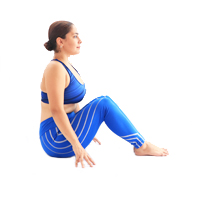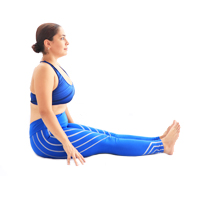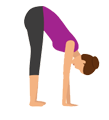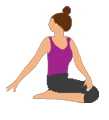| Pose Name | Sanskrit Name | Level | Targets |
|---|---|---|---|
| Staff Pose | Dandasana | Beginner | Helps improve posture |
What is Staff Pose?
The name of the staff pose comes from the Sanskrit words daṇḍa meaning staff, and āsana meaning pose. The 19th century Sritattvanidhi uses the name Dandasana for a different pose, the body held straight, supported by a rope. Hold the pose for one minute or longer.
How to do Staff Pose

Step 1
Sit on yoga mat with your legs together and extended in front of your torso. If your torso is leaning back, it may be because tight hamstrings are dragging the sitting bones toward the knees and the back of the pelvis toward the floor. It may be helpful to sit on a blanket or a bolster to lift the pelvis. A simple way to check your alignment is to sit with your back against a wall. The sacrum and the shoulder blades should touch the wall, but not lower back or the back of the head. Put a small rolled-up towel between the wall and the lower back. Sit towards the front of the sitting bones, and adjust the pubis and tail bone equidistant from the floor.

Final step
Without hardening the belly, firm the thighs, press them down against the, rotate them slightly toward each other, and draw the inner groins toward the sacrum. Flex your ankles, pressing out through your heels. To lengthen your front torso perpendicular to the floor, think of energy streaming upward from the pubis to the sternum, then down the back from the shoulders to the tail bone. Then imagine the tail lengthening into the floor. Imagine your spine as the "staff" at the vertical core of your torso, rooted firmly in the Earth, the support and pivot of all you do. You can stay at this pose for one minute or more.
| pose | Name | sunskrit |
|---|---|---|
 |
Downward-Facing Dog Pose | Adho Mukha Svanasana |
 |
Standing Forward Bend Pose | Uttanasana |
| pose | Name | sunskrit |
|---|---|---|
 |
Upward Plank Pose | Purvottanasana |
 |
Bharadvaja's Twist Pose | Bharadvajasana I |


